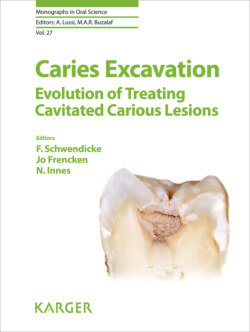Читать книгу Caries Excavation: Evolution of Treating Cavitated Carious Lesions - Группа авторов - Страница 43
На сайте Литреса книга снята с продажи.
Lesion Activity Assessment
ОглавлениеActive enamel carious lesions are more likely to turn into cavitated lesions than inactive enamel lesions [6, 7]. Using visual-tactile criteria, active enamel carious lesions look whitish, matte, and opaque, they feel rough on gently running a probe across the surface and are often covered by “tacky” plaque before professional tooth cleaning [6]. By contrast, inactive enamel carious lesions look shiny and they feel smooth on running a probe over the surface. In a 2-year survey, it was found that these criteria are more predictive for occlusal sites than for smooth surfaces [70]. This is probably due to the fact that, as with carious lesion detection, lesion activity assessment in approximal surfaces is hampered by the neighbouring teeth and by the gingival papilla and/or gingival bleeding. Therefore, and because lesion activity assessment despite calibration can result in less than perfect agreement [71], objective methods using reflection intensity [72] or chemiluminescence [73] have been described. However, these have only a limited body of evidence to support their use. Attempts have been carried out to use fluorescence to measure lesion activity by measuring a suspected area after air drying with compressed air [74], but the positive predictive value was reported to be 0.5, meaning one could achieve the same chance of being correct by the flip of a coin.
Visual-tactile inspection, correctly performed, has been and remains the method of choice for carious lesion diagnosis. If indicated, the diagnostic process may be supported by methods that contribute to lesion detection and to the assessment of lesion depth, especially for surfaces that are concealed to direct vision.
